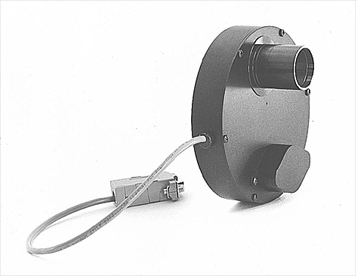 |
| Model CFW-8 Color Filter Wheel |
SBIG pioneered tricolor imaging by developing hardware and software to register and color balance Red, Green, and Blue images that display spectral emission of deep space objects. When interference filters are carefully selected to match the spectral regions of ionized gases the images taken through the filters can be summed together to represent the distribution of these gases. SBIG designed the following interference filters for use with the CFW-8:
Color Filter Passbands
| Filter | Passband (nm) |
| Red | 612-670 |
| Green | 488-574 |
| Blue | 392-508 |
Tricolor images are taken through the CFW-8 Color Filter Wheel and processed with CCDCOLOR
or the new CCDOPS for Windows software. The primary color images are taken through Red,
Green and Blue filters. After the images are taken they are processed with the software to
co-align the Red, Green and Blue images. The co-aligned image is then color balanced on
the computer monitor to become a tricolor RGB image, which can then be saved to disk. The
CCDCOLOR or CCDOPS for Windows software also allows the user to perform image processing
functions such as smoothing and sharpening as well as saving images in TIFF format.
The CFW-8 system is designed around the standard T-Thread. At the back end the system
aliaches to the imaging camera with a male T-Thread adaptor and can also be "direct
connected" to the Models ST-7 or ST-8 imaging cameras for a thinner, more rigid
mounting. On the front end a variety of T-Thread accessories are available including 1.25
inch (included) and 2 inch diameter nose pieces as well as a "Visual Back
Adaptor" for direct connection to SCT's.
The CFW-8 is operated through the CCDOPS software and utilizes a closed loop stepper
motor system with positional accuracy of ±0.01 inches. It holds up to five standard
1.25" diameter thread-in filters. Also supplied with the unit are Red, Green, and
Blue (RGB) interference filter sets and a clear filter (focusing). The new SBIG RGB
filters also block Infrared (IR) so an inline IR Blocking filter is no longer required.
These filters are mounted in standard size cells that normally fit into 1.25"
eyepiece barrels. The CFW-8 adds back focus of approximately 1 inch.
Although some examples of tricolor imaging are shown in this catalog it is difficult to
display the wide range of techniques that our customers have developed. The CFW-8 can
produce photographic quality tricolor images that rival color astrophotographs.
However, these RGB images also contain an entirely new and added level of valuable
information; the identification and distribution of different ionized gasses in an object.
SBIG also furnishes precision UBVRI filter sets with the Model CFW-8, filters which allow
the user to perform color photometry to measure the classification and temperature of
objects.
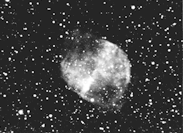 |
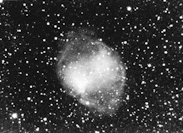 |
| Red Image | Green Image |
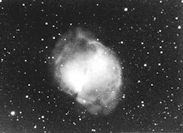 |
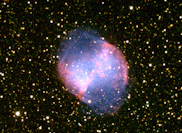 |
| Blue Image | Combined Image |
Note: The three separate Red Green and
Blue CCD images |
|
THE RGB PROCESS IN THREE SIMPLE STEPS |
| 1. Using the CFW-8 and CCDOPS software take three images with relative exposure ratios of (typically) 1:1:1.6 through Red, Green,and Blue filters respectively. |
| 2. Using CCDOPS COLOR or the new CCDOPS for Windows software register the three images and color balance them on the computer monitor. |
| 3. The result is a tricolor image. |
The Model AO-7 has been specifically designed to enable an ST-7 or ST-8 user to obtain
the ultimate in image resolution that his/her telescope and site can achieve. SBIG has
exploited the second guiding CCD detector in these imaging cameras to stabilize stellar
images, enhancing resolution. The AO-7 system has two components: a high speed tip-tilt
mirror for atmospheric correction, and new image enhancement software implementing the
Lucy-Richardson algorithm.
TIP-TILT HIGH SPEED GUIDING
Utilizing the second guiding CCD as an imaging sensor the guide star's position is read
out at rates up to 40 times a second, and the tip-tilt mirror adjusted to hold the star on
the designated pixel for the length of the imaging CCD's exposure. The tip-tilt mirror
moves and settles to within 20% of the commanded position in a mere 10 milliseconds,
dramatically faster response than any telescope drive is capable of achieving. The result
is sharper stars, and more clearly defined nebular features. As a general rule one can
guide at 10 frames a second on a 10th magnitude star with a 10 inch (25cm) telescope. The
range of the mirror for the Model ST-7 is ±5O pixels or 2 arcminutes of correction with
an 80 inch focal length telescope, enough to accomodate the periodic error of many mounts
without bothering to correct the RA drive axis directly. The Model AO-7 can do all of the
guiding. Inexpensive telescope mounts are now entirely capable of producing well guided
images.
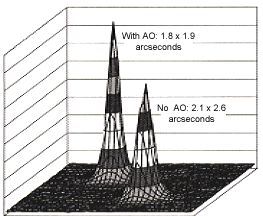 |
| As can be seen in this comparison image the AG gives an improvement in core intensity and halfwidth, improving the image resolution. |
LUCY-RICHARDSON IMAGE ENHANCEMENT
SBIG, in association with Benoit Schillings and Brad Wallis, has developed a
Lucy-Richardson image sharpening program that produces dramatic improvements in image
detail, visually at least a 2x improvement. The algorithms used are similar to those used
on the Hubble Space Telescope images. The results are the best we have ever seen
from amateur telescopes.
The enhancement program is Windows 95 compatible, and resembles SBIG's new Windows
processing products, not the well known CCDOPS which runs in the DOS environment. In
addition to the enhancement capability, the program allows the display of multiple images,
modification of background and range to enhance visibility of detail on the monitor, a
crosshairs mode for inspecting pixel values, negative image display mode, and horizontal
and vertical image rotation.
The AO system can be retrofitted to all Model ST-7 and ST-8 CCD imaging cameras by
inserting a new ROM and loading the upgraded software that accompanies the system. This
can be easily done by the user at his site. This remarkable system promises to have a
profound effect on CCD imaging by reducing the atmospheric turbulence, wind induced
vibrations, and eliminating the remaining periodic errors in most telescope drives.
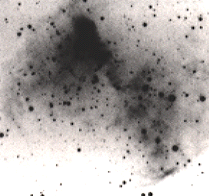 |
| Model AO-7 corrected 300 second CCD image taken with Model ST-7 at the prime focus of a C-11. The stars in this remarkable image are 1.0 to 1.1 arcseconds in diameter. |